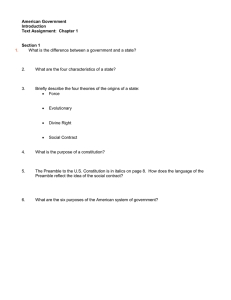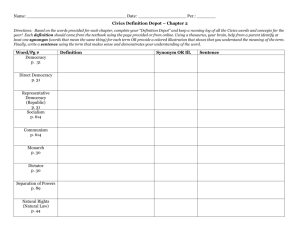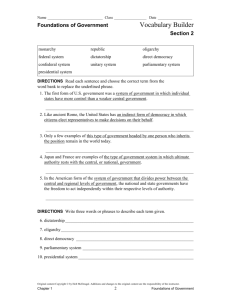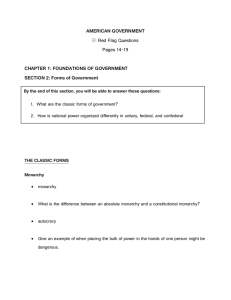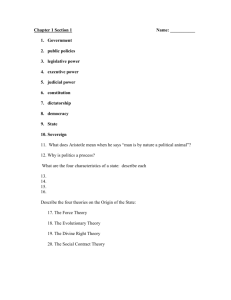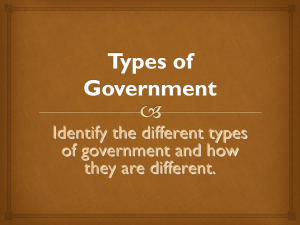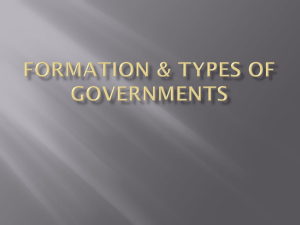Intro Ppt - Warren County Schools
advertisement
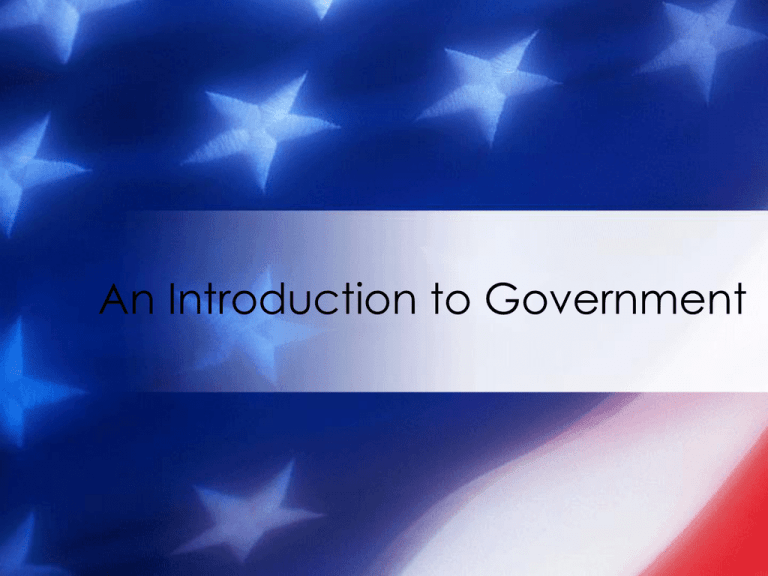
An Introduction to Government What is government? • Signs of government are found everywhere. •Government is defined as an institution with the power to make and enforce rules for a group of people. What is an institution? • An institution is a significant relationship, practice, or organization in a society or culture. What other institutions establish rules? 1. 2. 3. 4. 5. Churches Clubs Sports Schools Parents/Families What is government? … continued • The government has sovereignty over its citizens. ♦ Sovereignty – absolute authority or power ♦ Citizen – the members of a community or state • Governments of sovereign countries establish rules for their citizens by making laws. ♦ Law – a set of rules, made and enforced by government. What are the jobs of government? 1. Maintaining Order 2. Providing Services 3. Resolving Conflict 4. Promoting Values Which picture matches each job of government? Maintaining Order Governments maintain order by: 1. Enforcing laws that protect the safety and security of people and property 2. Protecting people from unfair or harmful business practices 3. Protecting the country from foreign invasion 4. Protecting and promoting businesses http://www.myfoxny.com/dpp/news/occupy-wallstreet-protest-broadens-scope-20111005 Providing Services What services does our government provide? 1. 2. 3. 4. 5. Building & maintaining roads and bridges Inspecting food and medicine Delivering mail Assisting the needy Building schools Resolving Conflict •Government helps resolve conflict by bringing people together to reach common goals through compromise. •Compromise is when each side gives up something to get something to resolve a conflict. Promoting Values • What values does our government try to promote by the laws/rules that they pass? 1. 2. 3. 4. 5. Safety Equality A good education Freedom Respect for individual rights Public Good • All of these jobs of government share a fundamental purpose: to serve the public good. − Public Good – The well-being of society as a whole. Types of Governments • Governments are different in 2 major ways: 1. Where their power to rule comes from 2. How the power is distributed among levels 1. Where their power to rule comes from − − − Monarchies Republics Dictatorships 2. How the power is distributed among levels − − − Unitary system Federal system Confederal system/Confederation Where their power comes from Monarchy, Republic, Dictatorship Monarchy • A monarch draws its power from being born into the ruling family (The ruler inherits it). • Monarch is just a BIG word for king or queen. • A monarchy is one of the oldest forms of government. Until the early part of the 1900’s most countries were ruled by monarchs. Today, around 40 countries have monarchs. • Besides a king or queen, today’s monarchs go by many names including sultan, emperor, and amir. • Many countries have constitutional monarchs – the king/queen is primarily the ceremonial head of state. − The queen of England is a constitutional monarch. Netherlands England Saudi Arabia Republic • In a republic the government gets its power from the people. − The terms republic & democracy can be used interchangeably. Dictatorship • In a dictatorship, power is achieved and maintained through force. • Power is concentrated in the hands of a single person or a small group. • Dictatorships are authoritarian because rulers answer only to themselves not the people. • Sometimes dictatorships are so extreme that they become totalitarian. − Totalitarian rulers have complete control over all aspects of citizen’s lives. • Types of Dictatorships: 1. Autocracy – rule by one. 2. Oligarchy – rule by a few Columbia Iraq Egypt Germany Libya Distribution of power among levels Unitary system, Federal system, Confederal system 3 Levels of Government 1. National or Federal level 2. State or Regional level 3. Local or city/county level 1. Unitary System • All power is held by the National (Federal) level of government. 2. Federal System • Power is divided among national, state, and local levels of government. 3. Confederal System • There may be no national government or a weak national government. Also called a confederation. Foundations of Democracy Types of Democracy • Democracy came from ancient Athens, Greece. • There are two types of democracy: 1. Direct Democracy- a system in which laws may be made directly by all citizens 2. Representative Democracy – a type of democracy where people elect officials to represent them in government. What makes a democracy endure? • During the 1900’s, democracy has been the one form of government that has not seen a decline. Benefits of Democracy 1. Allows choice 2. Recognizes individual worth 3. Promotes respect for the law 4. Protects minority rights 5. Promotes the public good
